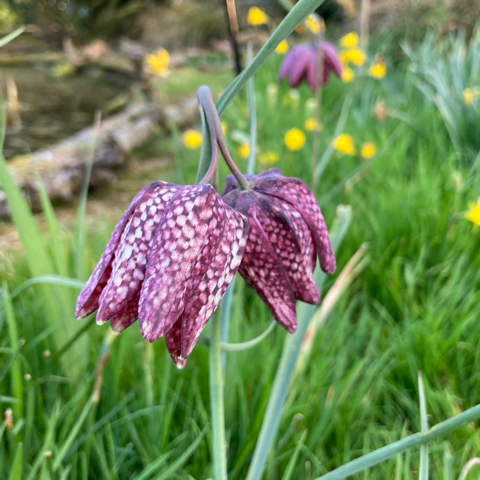April, the glorious month of spring! But as recent years have shown, it’s still a good idea to have some horticultural fleece to hand in case of a turn in the weather and some bitter northern winds.
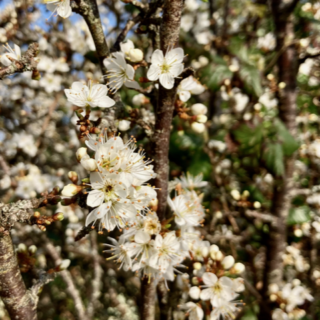 Hedgerows are full of blackthorn blossom suggesting there will be plenty of sloes for the autumn.
Hedgerows are full of blackthorn blossom suggesting there will be plenty of sloes for the autumn.
April could well be the busiest month of the year in the garden. Seeds to be sown, borders to be weeded, herbaceous plants to go in, less-than-fully-hardy shrubs to cut back, meanwhile keeping on top of the lawn as it really starts to grow.
In recent years, the prolonged periods of dry weather that we’ve had in spring have helped keep weeds at bay. I’ve also noticed that later on in the year, herbaceous plants are not as tall or prone to flopping if we’ve had a longer dry spell in the spring.
Trees and shrubs
April is the month when spring flowering shrubs and trees really get in to their stride. Beautiful Japanese cherries, 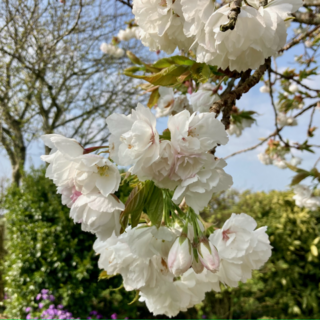 apples, pears, plums and crab apples. Tree such as blackthorn, amelanchier and pawlonia. Viburnum scents the air while shrubs with brightly coloured new leaves, like Fuchsia ‘Genii” and Acer ‘Bi-Ho’, add drama to the borders.
apples, pears, plums and crab apples. Tree such as blackthorn, amelanchier and pawlonia. Viburnum scents the air while shrubs with brightly coloured new leaves, like Fuchsia ‘Genii” and Acer ‘Bi-Ho’, add drama to the borders.
Amelanchiers are lovely, small trees, giving a dappled shade and interest in three seasons. In spring they have white flowers and the new growth is orange-bronze. In autumn they turn all shades of red and orange before losing their leaves. Crab apples have to be my other favourite for a small garden.
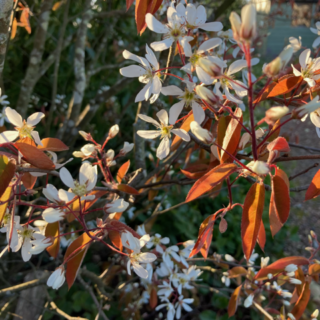 Figs and bay can be pruned now. I also prune olives, although this will prevent them flowering, but the flowers are fairly insignificant and in the UK I have never managed to get a decent crop of olives even in the warmest of years anyway. Those in the ground will appreciate a feed of something like chicken manure pellets. Pots can be fed at watering.
Figs and bay can be pruned now. I also prune olives, although this will prevent them flowering, but the flowers are fairly insignificant and in the UK I have never managed to get a decent crop of olives even in the warmest of years anyway. Those in the ground will appreciate a feed of something like chicken manure pellets. Pots can be fed at watering.
If you have shrubs like Japanese quince and flowering currant and they have finished flowering, you can prune these too. Take out older stems at the bottom to open the plant up and allow light to get to all the leaves.
Roses will also appreciate a good dose of feed raked into the soil around their bases, and a mulch to retain moisture over the summer. Camelias and rhododendrons are really good candidates for mulching, although keep it away from the base of their trunks. These plants need plenty of moisture in late summer, when it can be at a premium, while their flower buds are developing for the following spring.
Feed hedges and topiary, and mulch these as well if you can.
Trees and shrubs can still be planted now if they have been grown in containers. Pour plenty of water in to the planting hole before adding the plant, then keep it well watered all summer in the first year.
Watch fuchsias for early signs of fuchsia gall mite. If you have seen signs from the previous year, cut the plant right down to a few inches. As the stems grow back, cut off any that show leaf distortion as these will be carrying the mite. Disinfect secateurs after each cut with a wipe of something like surgical spirit. If the plant seems badly affected it might be best just to dig it up and destroy it.
Herbaceous borders
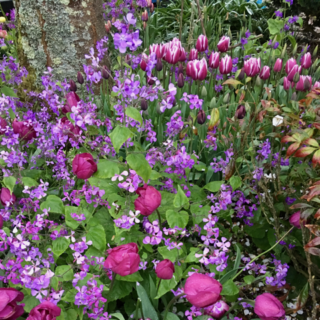 The word for the month is weeds! They will grow as fast as your back is turned. Weed over a border and next time you look it will be covered in seedlings again. Choose a warm, dry day and hoe if you can, then leave the weeds to dry out.
The word for the month is weeds! They will grow as fast as your back is turned. Weed over a border and next time you look it will be covered in seedlings again. Choose a warm, dry day and hoe if you can, then leave the weeds to dry out.
Many herbaceous plants will growing now. Your borders may be full of allium leaves which grow now to build the bulb up for flowering in a month or so. Amaryllis belladonna and colchicum (autumn crocus) do the same, before the leaves die back in summer leaving the flowers to appear from bare ground later on, giving both these plants the name of ‘naked ladies’.
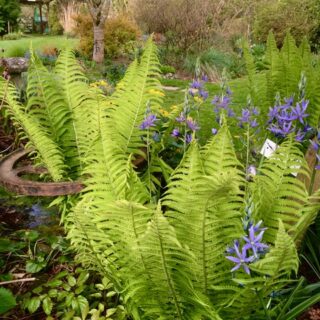 If you have ferns, clear away any old leaves that might be left to reveal the curled up fronds before they unfurl. You can still plant or lift and divide herbaceous plants, but be aware they will probably need watering during dry spells this year.
If you have ferns, clear away any old leaves that might be left to reveal the curled up fronds before they unfurl. You can still plant or lift and divide herbaceous plants, but be aware they will probably need watering during dry spells this year.
Keep sowing seeds of hardy annuals and thin out those that have already germinated. Keep them weed free so they don’t have too much competition.
You could also plant up hanging baskets and summer containers with plug plants, but keep them under cover in a greenhouse until May.
Lastly, have a wander around the garden with some jute twine and a pair of scissors and tie in the shoots of climbers before they start to wander off.
The productive garden
A lot of vegetables can be sown outside this month. It is still a busy month, with bean supports to build and the greenhouse occupants requiring water!
Outside you can sow carrots, beetroot (the two main staples of our veg patch!), chard, radishes, lettuce and spinach. For a bit of extra warmth to encourage germination, sow courgettes, cucumbers, sweet corn, melons and squashes indoors. Plant out chitted potatoes.
Pot up and pot on any seedlings that were sown in March, such as tomatoes, once they are large enough to handle. Tie them to a little cane to stop them flopping as they grow so fast. Keep potting them on when they need it until they are ready to go to their final growing place.
If you’re lucky enough to have rhubarb and asparagus, harvesting should be in full swing. Very tasty! If you’re looking for recipes for a glut of rhubarb I can recommend www.rhubarbinfo.com
Mulch and feed fruit trees and bushes, and pray for no late frosts.
Happy spring!
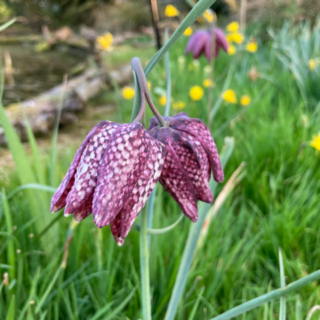
“Sweet April showers, do spring May flowers” – Thomas Tusser, A Hundred Good Points of Husbandry, 1557
Caroline Kenzie
Papaver Garden Design and Tuition (link to go on this text)

